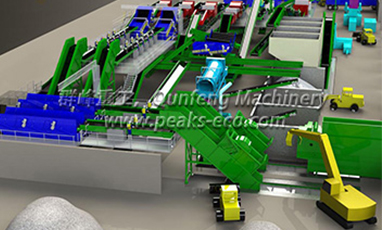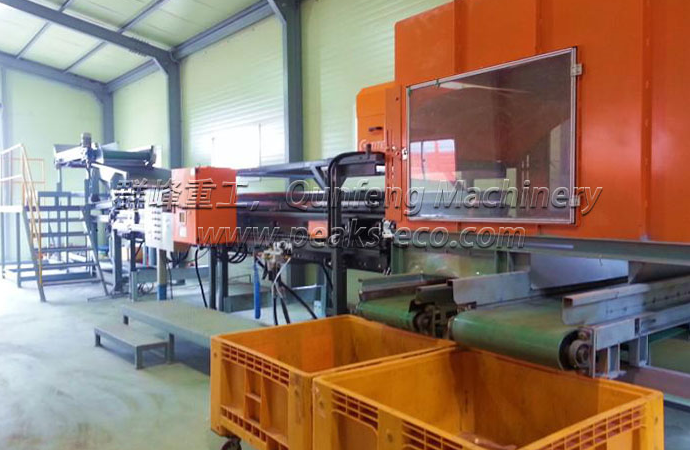With the continuous increase in the amount of garbage in the market, the hazards of land occupation and pollution of the water and soil environment are becoming more and more serious. To solve this fundamentally, it is necessary to strengthen the management of garbage discharge, treatment, recycling, and utilization, and realize garbage classification, reduction of harmless, and resource化.
Garbage sorting equipment mainly sorts, sorts, and recycles, and divides the collected garbage into three categories: construction garbage, domestic garbage, and unusable garbage.
Waste sorting has always been the bottleneck of waste treatment technology. Whether it is incineration, landfill treatment processes, or comprehensive treatment processes, many failure cases are due to incomplete waste sorting, resulting in the failure of the next process and the entire production line. run. The garbage sorting system is the core of the technology. The system adopts uniform garbage feeding, large-size garbage automatic sorting system, large-size garbage crushing system, automatic bagged garbage breaking bag, large organic matter automatic crushing system, and fully enclosed mechanization After air separation system, plastic water separation system, organic matter high temperature and high-pressure hydrolysis hydrothermal oxidation "hot separation" system and other processes, the municipal solid waste can be sorted into 1. Inorganic substances; 2. Sand soil Class; 3. Organic substances; 4. Non-recyclable combustible substances; 5. Film plastics; 6. Ferromagnetic substances; The separation purity of the above garbage can reach over 85%, and the separation purity of film plastics can reach 90% The above has laid a solid foundation for the "resource and industrialization" of waste treatment in the next process.

Garbage Sorting Equipment
Garbage sorting equipment manufacturers process the concrete blocks, waste bricks, mortar, muck, etc. in the garbage at the construction waste site, and crush them according to the needs of the construction to obtain recycled aggregates and a small amount The coarse aggregate is used as crushed stone for foundation reinforcement, road cushion, indoor floor cushion; fine aggregate can be made into environmentally friendly bricks such as hollow bricks, solid bricks, square bricks, and construction waste concrete porous bricks. The "composite brick" directly processed by the mobile crushing station has good anti-leakage characteristics, and the thermal resistance coefficient of the brick is 50 higher than the value specified in the relevant standards, the insulation performance is higher than that of the sintered brick, and the compressive strength is higher than that of the sintered brick 30. Bulk density, thermal performance, and many other indicators are better than ordinary clay bricks, which can fully meet national standards.
Technical parameter
Main treatment methods after the garbage sorting system factory:
1. Organic matter: leachate, sludge, high-efficiency ecological organic fertilizer after high-temperature and high-pressure hydrolysis and hydrothermal oxidation treatment;
2. Inorganic matter: slag waste, crushed and mixed to make building materials;
3. Plastics: wood-plastic board;
4. Ferromagnetic objects: mainly recycling;
5. Non-recoverable combustibles: utilization of waste heat from pyrolysis and gasification;
6. Sandy soil garbage: Naturally piled and fermented to make nutrient soil to improve the soil.
Outstanding advantages
1. Functions include sorting, conveying, winnowing, recycling, etc.
2. A set of pretreatment can be equipped with one or more garbage microbial treatment equipment. The capacity per hour is 1 ton, 2 ton, 3 ton, and other specifications, other specifications can be customized according to needs.
3. The humanized garbage sorting (customized) platform further screens out construction and domestic garbage.
4. The material is conveyed by frequency conversion speed regulation, low speed and high torque crushing and pressing, low noise operation.
5. When encountering a large solid object, the PLC automatically controls the forward and reverse rotation, and has an alarm to avoid failure.
The construction waste sorting station can separate waste fabrics, plastic bags and other debris from the construction waste recycled aggregates, and can also clean out large and medium-sized wooden blocks and plastic stool waste. After two screenings, the impurity separation rate was 98. With the rapid development of the domestic construction industry, a large amount of construction waste is generated during the construction process, and the urban construction waste is effectively recycled as a resource. The construction waste crushing station is a high-quality disposal method for solving construction waste. The mobile construction waste crushing station is flexible, convenient and highly maneuverable, which can save a lot of infrastructure and relocation costs; it can crush materials on site and move with the advancement of the raw material mining surface, thereby greatly reducing the transportation cost of materials. Production of rock crushing and mineral processing equipment such as crushing, screening, and transportation.
working principle
Used for domestic waste sorting and processing equipment, domestic waste processing equipment is mainly through a series of processes such as forklifts, conveyors, pair-roller tearing machines, shaftless rolling screens, magnetic vortex separators, air separation, dust collection, and gas treatment. Separate the copper, aluminum and non-ferrous metals, iron and magnetic materials, plastic rubber, stainless steel, heavy sandstone, organic matter and sundries, and large clothes from the original materials. The sorting rate can reach about 98%. It can handle all kinds of domestic garbage well, and it is an environmentally friendly recycling project that the state advocates.
The construction engineering waste sorting station adopts the form of winnowing and jigging, which can collect cement blocks, large bricks, brick slag, lime soil slag, scrap metal blocks, domestic garbage (food bags, woven bags, woodblocks, cloth pieces, etc.) Dry separation of the six major categories of materials ensures the smooth progress of the later classification and recycling of various garbage.

没有评论:
发表评论